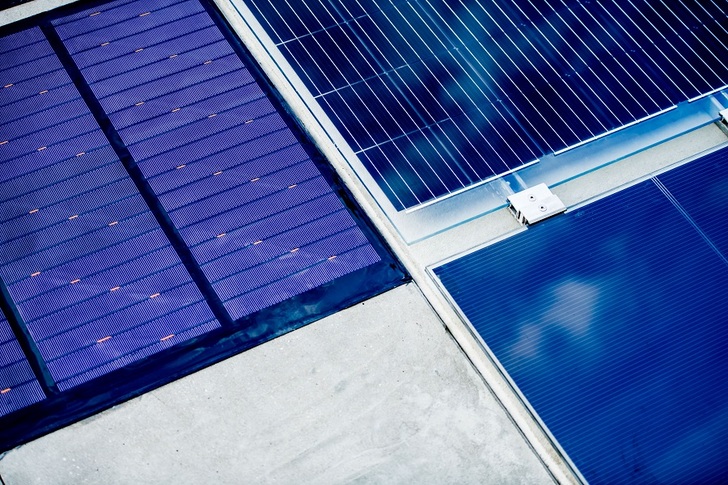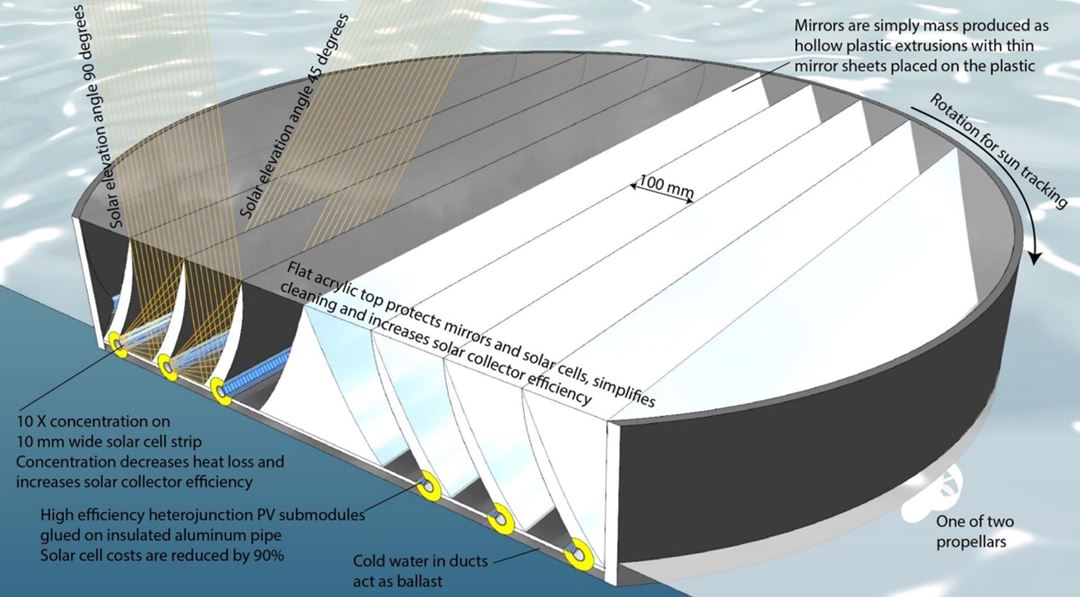https://www.pveurope.eu/solar-modules/rolling-solar-test-phase-pv-noise-barriers-started
Test phase of PV noise barriers started
Two test installations with several types of solar cell modules in Genk (Belgium) and Rosmalen (Netherlands) were built. The kick off for the test phase has started at both locations. In Belgium, the first private and public parties with an interest in large-scale pilots are now stepping forward. Thus, Rolling Solar paves the way for a cost-effective commercial roll-out of this technology.
EnergyVille is located on Thor Park in Genk. Here Rolling Solar partners UHasselt and imec (and KU Leuven and VITO) conduct research into sustainable energy and intelligent energy systems. A 13-metre-wide and 5-metre-high noise barrier is rising at the edge of the campus.
Also bifacial solar modules integrated
‘The noise barrier is built along a north-south road’, says Michaël Daenen, Professor Engineering Technology at UHasselt, one of the participants in Rolling Solar. ‘The part made of concrete is now standing. On the east side there are 3 types of solar cell modules: crystalline silicon PERC, thin film CdTe and thin film CIGS. The first 2 are mounted on frames. The CIGS modules, a development of TNO/Solliance, are glued directly to the concrete. It won’t be long before the remaining 8 meters of noise barrier will be realized by our new project partner Group Ceyssens, a developer and producer of windows. This section will consist of metal frames, in which CdTe and CIGS solar cell modules and bifacial crystalline silicon PERC solar cell modules are slid.’
Energy yield model
Although the noise barrier in Genk is still ‘under construction’, measurements on the already operational part have started. The data on energy yield is flowing in, using the power optimizers of SolarEdge with which the solar cell modules are equipped as a source. This information indicates that everything is working properly and will be monitored in the coming year, but according to Daenen this is not enough for further research.
Did you miss that? Utilizing surfaces with integrated PV solutions
‘Research center for nanoelectronics and digital technology imec played an important role in making choices regarding the solar cell technology. The scientists have developed a wonderful tool for modelling the energy yield. This includes all kinds of factors – the material, the environment, orientation, temperature, albedo... However, in order to optimally feed that model, the data on current and voltage that we now receive via the monitoring function of the power optimizers is suboptimal. SolarEdge’s power optimizers have a sample time of about 10 minutes. We want it to be 1 minute or less. In this way we can, for example, get a much more detailed picture of the influence of shadowing by clouds and passing cyclists or cars on the generated power. Currently, the electronics that make that possible are being installed. In addition to the efficiency of the solar cell modules, we also investigate the stability of the materials using all kinds of sensors that measure deformation and temperature.’
Sound-absorbing material
The energy transition is largely realized with the help of solar energy. According to Daenen however, the spatial layout of Belgium limits the possibilities for developing large solar farms. The use of noise barriers to generate renewable electricity is therefore highly promising, given the double use and their considerable total amount of surface. But keeping noise out remains the primary function. In Belgium, where motorways often cross cities; noise barriers are built at an angle of 90 degrees and sound absorption is often the norm. That is why all types of solar cell modules of the noise barrier in Genk are placed in duos. A transparent sound-absorbing material is positioned in front of 1 of the 2. In this way the acoustic effect and the difference in energy yield can be determined. However, the first material delivered did not pass the practical test; a loss of 30 percent energy yield was established in the laboratory. Construction and infrastructure company Habenu-van de Kreeke, the project partner that installed the pilot plant in Genk, is therefore now working on the development of new translucent material together with a subcontractor.’
Cost reduction
Daenen: ‘Everything we do within the Rolling Solar project is about preparing this PV application for market introduction, both for new PV noise barriers and retrofitting existing ones. We know from all kinds of projects, for example in Austria and the Netherlands, that it is technically possible. However, economic feasibility is key. Maximizing energy yield is only one side of the matter. Raising market awareness requires, in particular, cost reduction and building trust. The fact that prices for different types of solar cell modules such as bifacials are dropping is beneficial. But a large part of the costs lies in the integration into construction elements, construction itself and maintenance. So, there is a need for upscaling in all sorts of areas. To make progress, large-scale demonstrators are needed. That’s not part of Rolling Solar’s scope. However, we are paving the way.’
Exploratory talks
Daenen can’t complain about media attention. Not only the trade press, but also national newspapers and TV channels generously reported on the activities of the Rolling Solar consortium at Thor Park. This has now led to several conversations with interested developers and governments. ‘For example, the builder of the new glass sound barrier at the E19 near Zwijndrecht contacted us to discuss the possibilities, actually just too late in the development process to start a collaboration. We have also had several meetings with the City of Antwerp concerning the renewal of the ring road. In addition, we are in talks with Leefmilieu Brussel. These are also exploratory get togethers, but it does indicate that there is traction for the roll-out of larger projects. This includes setting up a workable cooperation model between all stakeholders which requires answering complex questions: who is the owner, how do we organize citizen participation, who does the maintenance...? It is also important to bring parties together and create trust.’
5 cassettes
On the site of Heijmans in Rosmalen in the Netherlands, a PV integrated noise barrier has also been created within the Rolling Solar project. The company in real estate, construction, infrastructure and installation technology realized this together with Soltech, Sanko Solar, Solliance and TNO EnergyTransition. The test set-up is 12 meters wide. A total of 5 cassettes of one meter high each, in which solar cell modules are incorporated, are stacked on a concrete plinth. The 2 lower ones contain two-sided crystalline silicon solar cell modules. The upper one is equipped with thin film CdTe solar cell modules, the middle 2 with double-sided thin film CIGS solar cell modules.
Irradiation patterns
The tests started at the beginning of this year and are going well according to innovation manager Stijn Verkuilen van Heijmans. The crystalline silicon solar cell modules serve as a reference for the measurements. The main interest is in the production and behavior of the thin film PV technologies in this particular application with its unique irradiation patterns and structural shadows. The CdTe and CIGS solar cell modules are placed in pairs to perform 2 different tests. IV curve measurements are being done on half of the system to see how the module behaves in these unusual irradiation patterns. The other half of the system is connected to the electricity grid via inverters to monitor the performance in energy yield. This allows us to investigate whether the system as a whole – the PV modules and inverter – works together well and functions properly.’
Positive business case
Verkuilen: ‘This is not the first PV noise barrier that we realized. Within the Solar Highways project, we built a 400-meter-long noise barrier with 136 crystalline silicon solar panels along the A50 near Uden. In doing so, we chose bifacials to create maximum energy yield and that remains the logical choice for this application for the future. That experience has taught us that it can be done technologically; the noise barrier has been functioning fine for almost 3 years now. But that does not mean that a large-scale market introduction is imminent. There is no positive business case yet; the payback period must be reduced. To achieve that reducing investment costs is the big task ahead. We regard that, in addition to our commitment to more design freedom in order to create more aesthetic value, as the main goal of our efforts within Rolling Solar.’
Mass customization
In the Netherlands, the structural frames for noise barriers are fixed, for example in terms of the tilt, the distance between the pillars and the thickness of the glass. This ensures the adequate prevention of noise pollution. Adding an additional PV function is secondary to this, and therefore requires the use of suitable solar cell modules. When you talk about cost reduction, applying a modular PV noise barrier which can be as built quickly the one in Rosmalen is of added value, as Verkuilen underlines. But in his opinion, first of all the prices of the PV specials must be lowered to bring down costs.
‘That’s why we see great opportunities in thin film applications, especially given the developments at TNO. We are now working mass customization: a flexible roll-to-roll production process in which thin film solar cell modules can be made in large volume at any desired size. In this regard, perovskite shows great promise and we hope to include this solar cell technology in our test installation in the future. The possibilities for commercial roll-out of PV noise barriers are of course also highly dependent on the rates at which you can sell electricity. Powering the electricity grid is not the most interesting option, that is a lesson we learned in Uden. Supplying local users, for example to an energy corporation, generates a much better return on investment. But that also makes the case complex.’
Press ahead
The Valley of Death. That’s how Verkuilen characterizes the current status of the development of PV noise barriers in the Netherlands. The Rolling Solar project should help to get past that phase, not only through technology development and cost reduction, but also by motivating all kinds of public and private stakeholders. ‘The infrastructure community is pretty conservative. Not that there are no innovations, but too often they get bogged down in small-scale trials. After we completed our project in Uden, several companies and road authorities visited us. However, their enthusiasm was tempered when the costs came up. This issue needs to tackled to move forward. At the moment we are picking the low-hanging fruit of the solar revolution. When we have finished that, we still have to press ahead to meet our climate goals. Integrating PV into infrastructure can make a significant contribution in doing just that, but it requires investing heavily now, also in large-scale pilots. The publicity surrounding the noise barrier in Genk seems to be setting things in motion in Belgium. That’s encouraging, and good incentive for us to speed up in the Netherlands.’
Rolling Solar consortium
In the Rolling Solar consortium, various companies and research institutes from Belgium, the Netherlands and Germany have joined forces to further explore the possibilities of integrating PV into the infrastructure, taking important steps in bringing that technology to market cost-effective. The project is part of the Interreg programme Euregio Meuse-Rhine. It is funded from the European Regional Development Fund and supported by the provinces of North Brabant, Flemish Brabant, Limburg and Liège, and the Dutch Ministry of Economic Affairs and Climate. (hcn)




